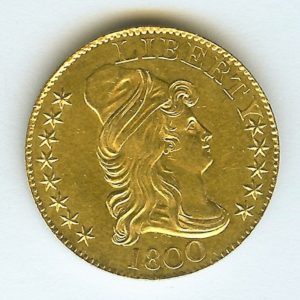Draped Bust $5 Gold Half Eagle (1795-1807)
In American coinage, the half eagles or $5 pieces include some of the greatest rarities, with 1822 $5 being particularly famous. The denomination was produced intermittently from 1795 to 1929. But the initial series that was later known as the Draped Bust Half Eagles continued to be minted until 1807 in two different subtypes. Those were the Draped Bust, Small Eagle (1795-1798) and Draped Bust, Heraldic Eagle (1795-1807).
The $5 gold denomination was the first gold coin that was struck for the USA with the design sometimes referred to as “Capped Bust to Right” or “Turban Head.”
The denomination is one of the most popular coins for collecting but the problems with low mintages and heavy melting when the coins were struck took their toll. This resulted in finding problem-free, original surface coins a major challenge.
Draped Bust, Small Eagle (1795-1798)
When Henry DeSaussure replaced David Rittenhouse as Mint Director in June 1795, his goal was to strike gold coins and improve the current designs. Chief Engraver Robert Scot, under the orders of Rittenhouse, prepared dies that will be the half eagles, the very first gold coins that the United States Mint produced.
From 1795 through 1798, the Draped Bust, Small Eagle was produced. Unfortunately, it did not escape the huge melts that caused the destruction of the major bulk of gold coinage in the US that was minted before 1834.
This resulted in the surviving coins to be very scarce, especially the high-grade kind.
The coins that are more difficult to locate today than those issued in the first year are those from 1796 that are overdates—1796/5. If ever some coins are found, very few of them are in mint state.
It was in 1798 when the Small Eagle series of Draped Bust Half Eagles came to an end.
Draped Bust, Heraldic Eagle (1795-1807)
The Draped Bust, Heraldic Eagle was born in response to the criticism that the Draped Bust, Small Eagle received in reference to its design. Chief Engraver Robert Scot set to improve the design and gave the “scrawny” eagle, as the critics called it, a makeover.
The result is the Heraldic Eagle reverse motif. The design was inspired by the bird on the Great Seal of the United States.
Minted only on 10 dates, the series of Draped Bust, Heraldic Eagle was considered a rarity and rich in history. It is also shrouded in mystery because some of the coins’ obverses that was dated 1795, 1796/5, and 1797 showed the cut reverse dies of the Heraldic Eagle when it wasn’t until early 1798 when Scot cut the dies.
Changes were something that this subset of Draped Bust went through in different years.
- The Heraldic reverse that was first used in 1798 had a large 8 in the date and 13 reverse stars.
- The pieces struck in 1799 include those with a large final 9 and stars in either small or large sizes.
- The half eagles in 1804, were known to have a small 8 and small over large 8.
Suffice to say that the Draped Bust, Heraldic Eagle was constantly changing in either small or notable details.
